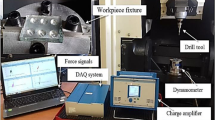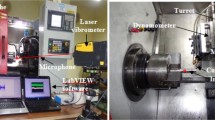Abstract
Drilling is one of the most common and fundamental machining processes. It is most frequently performed in material removal and is used as a preliminary step for many operations, such as reaming, tapping and boring. Because of their importance in nearly all production operations, twist drills have been the subject of numerous investigations. The aim of this study is to identify suitable parameters for the prediction of surface roughness. Back propagation neural networks are used for the detection of surface roughness. Drill diameter, cutting speed, feed and machining time are given as inputs to the neural network structure and surface roughness was estimated. Drilling experiments with 12 mm drills are performed at three cutting speeds and feeds. The number of neurons are selected from 1,2,3, ..., 20. The learning rate was selected as 0.01, and no smoothing factor was used. The best structure of neural network was selected based on a criteria including the minimum of sum of squares with the actual value of surface roughness. For mathematical analysis, an inverse coefficient matrix method was used for calculating the estimated values of surface roughness. Comparative analysis was performed between actual values and estimated values obtained by mathematical analysis and neural network structures.
Similar content being viewed by others
References
Yao Y, Xiaoli (1999) Tool wear detection with fuzzy classification and wavelet analysis. Int J Mach Tools Manuf 39:1525–1538
Li PG, Wu SM (1998) Monitoring of drill wear states by a fuzzy pattern recognition technique. J Eng Ind 110:352–359
Lee BY, Tarng YS (2001) Surface roughness inspection by computer vision in turning operation. Int J Mach Tools Manuf 39:1251–1263
Xiaoli, Tso SK (1999) Drill wear monitoring based on current signals. Wear 231:172–178
Chang-Xue, Xian-Feng (1999) Surface roughness predictive modeling neural network verses regression analysis. Technical Report, Department of Industrial and Manufacturing Engineering, Bradley University, Peoria, USA
Venkatesh K, Zhou M (1997) Design of artificial neural networks for tool wear monitoring. J Intell Manuf 8:215–226
Chen JC (2001) Neural networks and neural fuzzy approaches in process surface roughness recognition system for end milling. Iowa State University
Wang J, Tang WS (2001) Neural network applications in intelligent manufacturing, an updated survey. The Chinese University of Hong Kong
Andrilli S (2000) Elementary linear algebra. Academic Press, pp 45–126
Neema ML, Pande PC (1979) Tap performance evaluation. In: Proceedings of Second Conference on Mechanical Engineering, India, pp 247–251
Pande PC, Neema ML (1978) Some investigations on tapping of mild steel nuts. In: Proceedings of the 8th AIMTDR Conference, IIT, Bombay, India, pp 347–352
Irwin, Warwick (1999) Neural network application and control. British Library, pp 15–67
Graupe D (1999) Principles of ANN. World Scientific Publications, pp 34–89
Gurney K (1999) An introduction to neural network. UCL Press, pp 6–56
Liu T, Chen WY (1998) Intelligence detection of drill wear. J Syst Signals Process 12:863–873
Neema ML, Pande PC (1980) The effect of magnetization on the wear of HSS steel tools. Wear 59:355–362
Author information
Authors and Affiliations
Corresponding author
Additional information
An erratum to this article is available at http://dx.doi.org/10.1007/s00170-006-0717-x.
Rights and permissions
About this article
Cite this article
Sanjay, C., Jyothi, C. A study of surface roughness in drilling using mathematical analysis and neural networks. Int J Adv Manuf Technol 29, 846–852 (2006). https://doi.org/10.1007/s00170-005-2538-8
Received:
Accepted:
Published:
Issue Date:
DOI: https://doi.org/10.1007/s00170-005-2538-8




